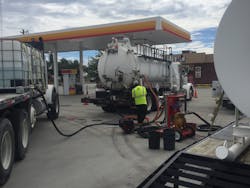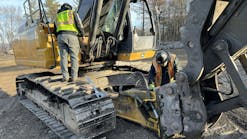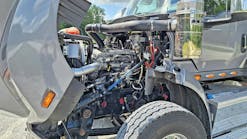In summary, those issues are an increasing incidence of corrosion in diesel-fuel storage tanks and diesel-fuel flashpoints that fall below industry specifications.
Severe and rapid corrosion in the vapor areas (ullage) of steel storage tanks, as well as corrosion of steel components within the tank, whether steel or fiberglass, seems to be occurring with increasing frequency.
Link to the current EPA report
Link to the Clean Diesel Fuel Alliance report
Scott Knowles, co-owner of Petroleum Tec, a North Carolina-based fuel-storage maintenance company that includes tank cleaning and fuel polishing among its services, says that he began to notice the corrosion problem now and then several years ago, but now encounters it almost weekly. And in many instances, says Knowles, tank owners are unaware of the problem.
The flashpoint issue came to CE’s attention via Howard Chesneau, president of Fuel Quality Services, a fuel-management/consulting firm and additive developer that assists clients in solving fuel-related issues. Chesneau passed along research conducted by the Georgia Department of Agriculture’s State Fuel Oil Laboratory, David Au, state oil chemist, director. The laboratory regularly tests motor fuels used in the state of Georgia and became concerned when an increasing number of ULSD samples showed depressed flashpoints. (Flashpoint is the lowest temperature at which enough of a particular fuel vaporizes to form a combustible concentration of gas.)
Diesel flashpoint concerns
The ASTM (American Society for Testing and Materials) specification for diesel fuel, D975, requires that standard No. 2 diesel fuel have a flashpoint of at least 125F, classifying it among combustible liquids, which have flashpoints between 100F and 200F. Flammable liquids have ratings less than 100F, such as gasoline at -40F.
If the flashpoint is out of specification on the low side, then ULSD becomes more volatile, possibly upsetting the precise calibration of fuel and emissions-control systems in today’s machines and potentially causing damage to engines and exhaust systems.
“Flashpoint is a key criterion [in diesel-fuel specifications],” says the report issued by Georgia’s State Fuel Oil Laboratory. “If ignition is too slow, the engine might not combust the fuel appropriately, resulting in difficult starting or incomplete burning. On the other side, using a fuel with an ignition point that is too fast [lowered flashpoint] might result in premature ignition. Both conditions could cause severe engine damage.”
Another implication for lowered flashpoints in ULSD might be the manner in which diesel fuel is handled. If the flashpoint is depressed below 100F, then does diesel fuel become subject to OSHA regulations for the transport, storage, emergency response, and insurance liabilities of a flammable liquid?
Among the most disconcerting aspects of the flashpoint issue for Georgia is the rapid increase in out-of-spec situations.
“By comparing diesel-flashpoint data for the last three fiscal years,” says the state’s report, “the flashpoint failure rate has increased tremendously, almost doubling every year.” The state issued stop-sale orders for diesel at 220 retail stations in 2015—more stop-sale orders than issued for water and sediment contamination.
So as not to keep you in suspense about the suspected cause of low flashpoints in Georgia’s ULSD, the state has reached this tentative conclusion: “Gasoline apparently is the main source of contamination in diesel fuel at the retailers. Since many carriers practice switch-loading—transporting gasoline prior to hauling diesel fuel—the residual gasoline inside the truck compartment is most likely the root cause of the flashpoint depression.”
The state’s investigation included testing diesel flashpoints at large fuel-distribution terminals in the Atlanta and Savannah areas; flashpoint temperatures ranged between 130F and 150F. As a sort of smoking-gun indictment of switch-loading’s role in lowered flashpoints, the report cites an instance in which fuel at the terminal had a flashpoint of 148F, but after being loaded into a switch-loading tanker, the flashpoint dropped to less than 100F.
Because gasoline has such a low flashpoint temperature, says the report, a small amount can depress diesel flashpoint substantially—as much as 40F if contaminated with 1 percent winter-grade gasoline (which, versus summer-grade, has more light hydrocarbons that easily vaporize). The hydrocarbon vapors from gasoline, says the report, can be readily absorbed into diesel fuel and, in fact, “vapors might have more impact than liquid gasoline on flashpoint depression.”
The report also noted that many tankers are split-loaded, having several compartments for various products, perhaps carrying gasoline in three and ULSD in a fourth. As the content of the compartments is shaken as the tanker travels, vapors are released into the head space. If the tanker has a common vent to extract vapors, says the report, then it’s possible that vapors from gasoline—which has a relatively high “vapor pressure” (that is, vapor escapes easily)—could migrate to and be absorbed by diesel fuel, which has a much lower vapor pressure.
Also, during delivery, if the gasoline-vapor recovery line is connected to a storage tank prior to unloading the diesel compartment, experimentation showed that gasoline vapors were absorbed by the diesel fuel via the common vent. “Gasoline-vapor diffusion to liquid diesel is a very complex phenomenon,” says the report, “and further investigation is necessary to understand the mechanism.”
The point to be made is this: If the switch-loading/split-loading tankers that are delivering out-of-spec No.2 diesel to retail outlets are the same trucks that are delivering ULSD to storage tanks used by equipment owners, then fleet managers might want to raise the issue of flashpoint depression with their fuel suppliers.
Fuel tank corrosion
A July 2016 report released by the Environmental Protection Agency (EPA), “Investigation of Corrosion-Influencing Factors in Underground Storage Tanks with Diesel Service,” sums up the tank-corrosion issue:
“The major finding...is that moderate to severe corrosion on metal components in UST [underground storage tank] systems...could be a very common occurrence. Observations suggest that corrosion may be commonly severe on metal surfaces in the upper vapor space of UST systems, an area that before 2007 was not known to be prone to corrosion. Furthermore, it appears many owners may not be aware of the corrosion, nor are they aware that corrosion, which could affect the operability of their UST systems, could already be at an advanced stage.”
“The EPA’s main concern,” says Petroleum Tec’s Knowles, “is that corrosion will jeopardize over-fill-protection and monitoring equipment, resulting in possible ground-water contamination, either by allowing a tank to be overfilled or by not detecting a leak. The EPA report focuses on underground tanks, but we’re seeing corrosion as frequently in above-ground tanks—and also starting to see it in machine fuel tanks.”
The EPA states that its current report builds on the industry’s first study about rapid and severe corrosion in USTs—a six-tank study commissioned by the Clean Diesel Fuel Alliance (CDFA) in 2012. The CDFA investigation reached this conclusion:
“The project’s final hypothesis...is that corrosion in systems storing and dispensing ULSD is likely due to the dispersal of acetic acid throughout USTs. It is likely produced by Acetobacter bacteria feeding on low levels of ethanol contamination. Dispersed into the humid vapor space by the higher vapor pressure (0.5 psi compared with 0.1 psi for ULSD) and by disturbances during fuel deliveries, acetic acid is deposited throughout the system. This results in a cycle of wetting and drying of equipment, concentrating the acetic acid on metallic equipment and corroding it quite severely and rapidly.”
What the CDFA report suggested has been termed “microbiologically influenced corrosion” (MIC), a process by which, in the presence of water and oxygen, bacteria oxidize the ethanol and create acetic acid as a byproduct of microbial metabolism. The report stated that the source of ethanol was not conclusively known, but suggested that “diesel fuel often is delivered in the same trucks as ethanol-blended gasoline” and also that a manifold-type ventilation system between gasoline tanks and ULSD tanks could allow some cross contamination of ethanol into the ULSD.
According to the current EPA report, the CDFA report also suggested that MIC could occur as a result of microbial populations feeding on constituents of the diesel fuel itself, including glycerin, a byproduct of biodiesel production.
The conclusions of the 60-page EPA report, based on investigating 42 USTs, are tentative. “Our research suggests that MIC is likely involved in the moderate or severe internal corrosion in USTs storing diesel. Further identification of specific bacteria was not possible, however, within the scope of our research. Therefore, while previous research hypotheses...were not disproved by the results of our research, validation would be speculative.”
Petroleum Tec’s Knowles gives a view of the corrosion from the front lines. “The corrosion appears to be organic in nature—like living particles that grow in the vapor areas of the tank. It’s a brittle material that falls off the top of the tank and gets picked up by the fuel pump in both bulk-storage systems and machines. If I get a call from a tank owner or fuel supplier about filters and pre-screens plugging with what they call rust or ‘coffee grounds,’ I immediately know the problem.”
Ed English, vice president and technical director, Fuel Quality Services, gives a thumbnail summary of the “coffee-grounds” issue. “Perhaps 18 to 24 months after the introduction of ULSD in 2006, the industry started noticing unusual occurrences, such as dispenser filters filling with what looked like a coffee-grounds material and corrosion occurring in the riser tubes of USTs and in other areas of the tank not normally exhibiting corrosion. More importantly, corrosion also was occurring in certain vehicle tanks and causing problems with the fuel-injection system.”
The problem prompted the Petroleum Equipment Institute to bring together various industry groups with the EPA’s Office of Underground Storage Tanks in 2010, says English. The basic assumption, he says, was that the change to ULSD was somehow the cause of the problem. The investigative group was eventually headed by the American Petroleum Institute and led to the CDFA report that pointed to ethanol-related MIC as the possible culprit, perhaps promoted by the lack of sulfur, which served as a natural biocide in higher-sulfur fuels.
Mitigating the problem
Fuel Quality Services’ Dave Forester, director of global products development, sums up the basic rule tank owners must follow to mitigate the corrosion issue. “It’s all related to water; you’re not going to have microbial growth in a tank unless you have water. If you have an absence of water in the tank, then you can have ethanol or glycerin present, but they will have no effect on the system, because they won’t be oxidized and cause acid formation and subsequent corrosion.”
If an underground tank is not tilted toward the fill tube, says Forester, then water won’t show up when the gauging stick is used; instead, water will collect at the submersible-turbine end. And an automatic monitoring system, depending where the sensor is located, he says, usually won’t pick up the presence of water until it’s 3/4 to 1 inch deep on the tank bottom. Chesneau says that his experience is that probably 40 percent of tanks are tilted toward the pump-out end.
“Tanks have a tendency to settle,” says Chesneau, “and unless you have the ability to sample both ends of the tank without having to pull the pump, then 99 percent of the time you’ll miss the water. But if you know the location of the water, you can get enough of it out to reduce the viability of the organisms to the point that they’re not a problem. If tank owners want to be proactive about controlling biological activity, they can use a biocide periodically, based on the turnover of the system and how much water they find.”
Petroleum Tec’s Knowles advises that if corrosion is severe, then the fuel be extracted and polished (cleaned and dried) and the tank cleaned with high-pressure water and all debris vacuumed out. He then recommends keeping a maintenance dose of biocide in the tank, based on the individual system. He says that one of his clients, Carolina Sunrock, a North Carolina-based aggregates producer, after having an above-ground tank cleaned, treated the tank with a biocide three times a year, but found that the overlap of protection between loads was not sufficient.
“Regardless of whatever else is happening upstream in the diesel-fuel supply chain,” says Carolina Sunrock’s manager of fleet services, Leigh Dennis, CEM, “for the end user, the presence of water is the key to the development of MIC. Working with Petroleum Tec, we found that the only way to control moisture and microbial activity was to treat diesel fuel with biocide every two months and remove water every six months in our above-ground tanks.”
Knowles also dispels a common misconception about tank maintenance. “Many tank owners think that if they’re using high volumes of fuel, then problems with tank cleanliness are minimized,” he says. “Actually, it’s just the opposite—because the industry generally accepts that every tanker load of fuel can add up to three or four gallons of water and a quart of trash to the storage tank—but the fuel will still be in spec.”
Carolina Sunrock’s Dennis, long concerned about the cleanliness of diesel fuel arriving at the company’s bulk tanks, makes this observation. “The case for filtering incoming bulk-fuel to remove particulates and water has become disturbingly apparent.”
Dennis is of the opinion that any fuel-management program that still subscribes to the ASTM “clear and bright” standard to assess fuel quality is out of touch with the critical need for cleanliness demanded by today’s Tier 4-Final fuel systems.
“Some of these programs suggest collecting samples to test for moisture by dipping the sample cylinder into the fuel 6 inches above the bottom of the tank, reasoning that free water and biological growth from the very bottom of the tank will spoil the sample. Really? I want my tank-maintenance service to dredge the bottom of my tanks, remove the water, and kill what grows there. Buyer beware.”
Fuel Quality Services’ Chesneau leaves tank owners with this further counsel: “Periodic biocide treatment will help reduce the issue, but it’s not in itself a silver bullet. All biocides kill things, but some do it better and faster and are more applicable to systems with rapid fuel turnover. You have to read the fine print.”





